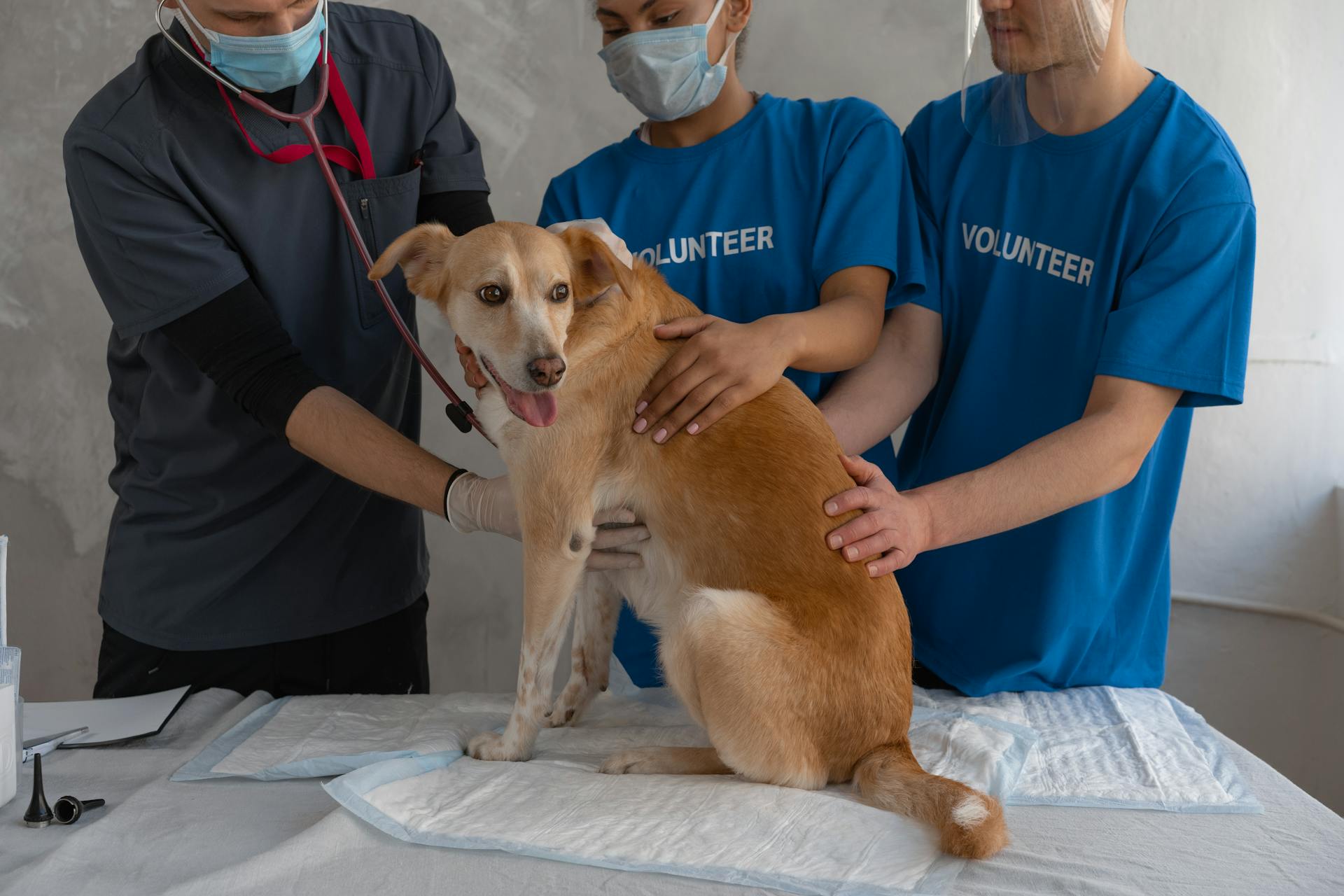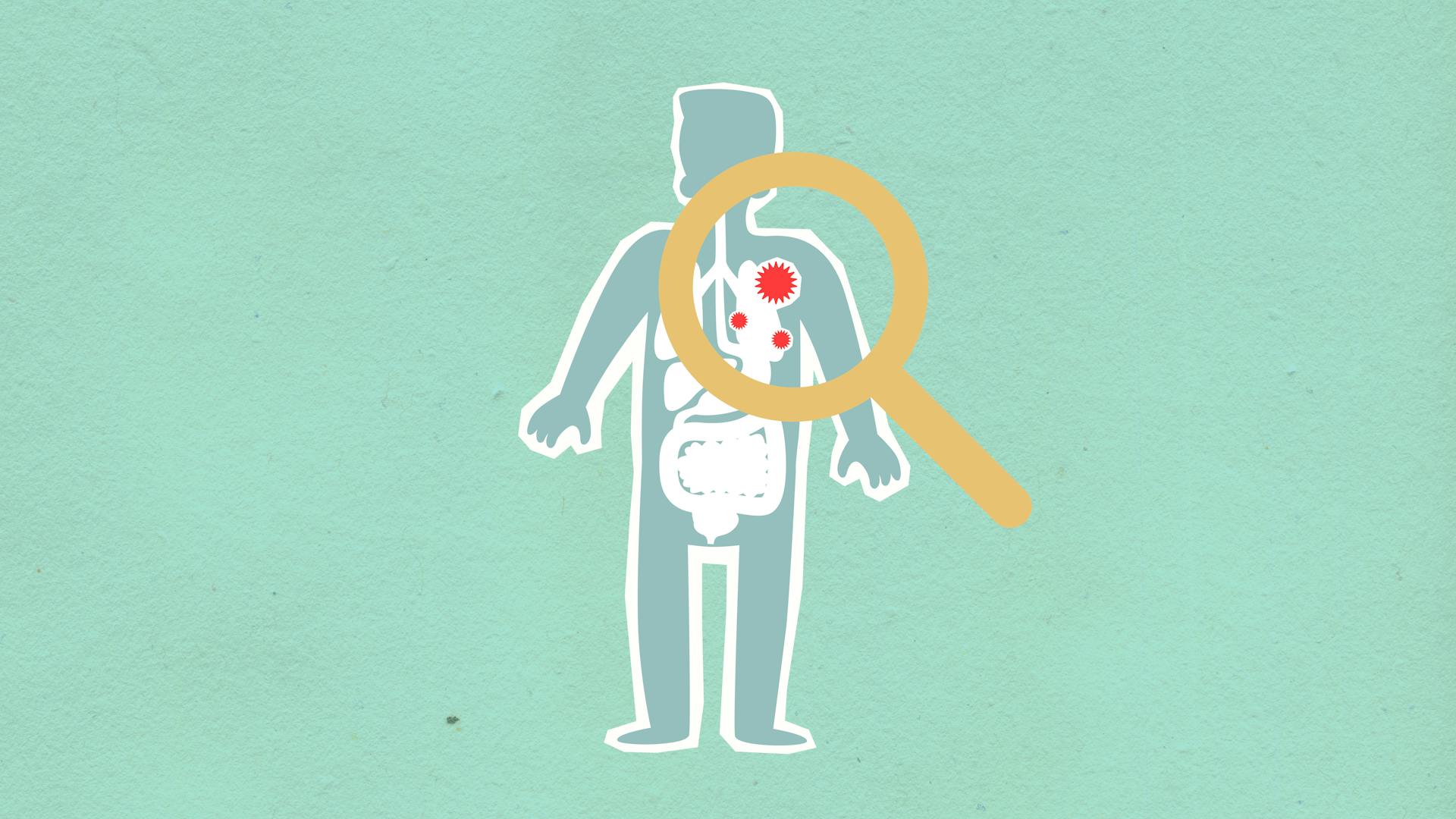
Canine distemper is a serious and often fatal disease that affects dogs worldwide. The survival rate for dogs with canine distemper is around 50-60%.
Early symptoms of canine distemper can be subtle, but they can quickly progress to more severe health issues. These can include fever, vomiting, diarrhea, and a lack of appetite.
The disease can spread through contact with an infected dog's saliva, mucus, or other bodily fluids. This means that even a simple interaction, such as a nose-to-nose greeting, can be enough to transmit the virus.
Prompt veterinary care is essential for managing canine distemper.
If this caught your attention, see: Lifespan of Dog with Kidney Disease
Causes and Prevention
Canine distemper is a serious disease that can have devastating effects on dogs. The virus can be transmitted through respiratory secretions, such as coughing and sneezing, as well as other bodily fluids like urine, vomit, and stool.
Contact with an infected animal is the most common way for distemper to spread, but shared food bowls and contaminated supplies, surfaces, and equipment can also pose a risk. This is why it's essential to keep your dog's environment clean and sanitized.
Dogs, ferrets, and wildlife can appear healthy and still be a source of the distemper virus. Recovered dogs may remain contagious for several months, which means they can still spread the virus even after they've recovered.
The good news is that there's no evidence that humans can get canine distemper. However, ferrets are also at risk for being infected with the canine distemper virus and should be vaccinated against it.
To prevent the spread of distemper, make sure to:
- Keep your dog's environment clean and sanitized
- Limit contact with other dogs, especially if they're not up to date on their vaccinations
- Make sure your dog is vaccinated against distemper, especially if you live in an area with a high incidence of the disease
- Don't share food or water bowls with other dogs
By taking these precautions, you can help keep your dog safe from canine distemper.
Clinical Signs and Diagnosis
Clinical signs of canine distemper can be mistaken for other infections, such as kennel cough, making diagnosis challenging. Some dogs may develop subclinical infections where they shed the virus but don't show outward signs of illness.
Clinical signs include upper respiratory signs, vomiting, diarrhea, lethargy, decreased appetite, neck/back pain or stiffness, and twitching or seizures.
Dogs can develop a wide range of clinical signs and levels of severity, including respiratory, gastrointestinal, and neurologic signs. More severe signs may be seen in puppies.
The most practical and commonly-used test for diagnosing CDV is a respiratory PCR panel, which can detect viral nucleic acid in nasal, deep pharyngeal, and conjunctival swabs.
A complete necropsy with sample collection can be the most efficient and reliable means to definitively diagnose CDV in an individual animal or population.
Here are some common symptoms of canine distemper:
- Yellow or green eye discharge
- Nasal discharge
- Coughing
- Sneezing
- Depression
- Vomiting
- Decreased appetite
- Diarrhea
These symptoms can progress to include tremors, seizures, crusting of the nose and footpads, and partial or complete paralysis.
Clinical Signs
The clinical signs of canine distemper can be quite varied and may resemble those of a minor cold or kennel cough. Some dogs may not show any outward signs of illness, especially if they have partial immunity.
Upper respiratory signs are common, including eye or nose discharge, coughing, and sneezing. These symptoms can be accompanied by vomiting, diarrhea, lethargy, and decreased appetite.
As the disease progresses, dogs may experience neurological signs, such as neck/back pain or stiffness, twitching or seizures, and myoclonus, which is highly suggestive of CDV infection.
Here are some common clinical signs of canine distemper:
- Upper respiratory signs (eye or nose discharge, coughing, sneezing)
- Vomiting
- Diarrhea
- Lethargy
- Decreased appetite
- Neck/back pain or stiffness
- Twitching or seizures
It's essential to note that some dogs may only exhibit mild symptoms, while others may experience severe and life-threatening complications.
How to Diagnose
Diagnosing canine distemper can be a complex process, but with the right approach, you can get an accurate diagnosis for your furry friend.
A thorough physical exam is the first step in diagnosing distemper, which involves checking for abnormalities such as eye or nose discharge, abnormal lung or heart sounds, and signs of dehydration.
Your veterinarian will want to know when symptoms began, whether your dog is up to date on his distemper vaccine, and if he has been in close contact with any other animals recently.
To confirm a diagnosis, your veterinarian may perform a PCR test, which detects the actual virus, or an antibody test to determine a dog's exposure to the virus.
A different take: How Do Dogs Get Canine Distemper
Various samples can be used for testing, including blood, urine, eye or nose discharge, and nasal, deep pharyngeal, and conjunctival swabs.
A complete necropsy with proper sample collection is the most efficient and reliable means to definitively diagnose CDV in an individual animal or population.
Here are the key steps to follow when collecting and submitting samples for respiratory pathogen PCR testing:
- Collect samples from dogs exhibiting clinical signs of disease as early in the course of infection as possible and before starting antibiotics.
- Follow a proper sample collection technique to ensure accurate test results.
- Select a PCR panel that includes quantitative distemper results to provide information about the amount of virus detected.
By following these steps and working closely with your veterinarian, you can get an accurate diagnosis and start your dog on the road to recovery.
Transmission and Incubation
The incubation period of canine distemper can be quite lengthy, usually lasting 1-2 weeks from exposure to the development of clinical signs, although it can be as long as 6 weeks in some cases.
Dogs can be infected and not show any outward signs of illness, a phenomenon known as sub-clinical or mild infection.
These infected dogs can still shed the virus, and in fact, substantial viral shedding can occur in sub-clinically affected animals.
After recovery, many dogs will continue to shed the virus for weeks or even up to 4 months.
Careful isolation of all dogs with upper respiratory signs is crucial to prevent the spread of distemper where it's a concern.
Management and Care
Dogs who have not developed neurologic disease generally have the best prognosis for recovery.
Supportive care is the mainstay of CDV treatment, and all treatments should be conducted under the direct guidance of a licensed veterinarian. This includes intensive nursing care, fluid replacement and vascular support, nutrition, and treatment or prevention of secondary bacterial infections.
Dogs recovering from distemper should attend all follow-up veterinary appointments to support optimal health and well-being, and some may benefit from appetite stimulants during recovery.
To reduce the spread of the virus, it's essential to isolate a dog with distemper from other animals until he has fully recovered and is no longer deemed contagious by a veterinarian.
Here's a list of essential steps to take when caring for a dog with distemper:
- Provide intensive nursing care
- Replace lost fluids and support the vascular system
- Ensure proper nutrition
- Treat or prevent secondary bacterial infections
- Keep a close eye out for changes in behavior or symptoms
Thoroughly cleaning and disinfecting household items, such as bedding and dog bowls, is also crucial to remove the virus from home.
Management
Dogs with distemper can be contagious for several months, so it's crucial to isolate them from other animals until they've fully recovered and a veterinarian deems them no longer contagious.
Intriguing read: Is Pancreatitis in Dogs Contagious

Recovery from distemper requires thorough cleaning and disinfecting of household items, such as bedding and dog bowls, to remove the virus from the home.
Dogs recovering from distemper need to attend all follow-up veterinary appointments to support their optimal health and well-being.
Some dogs may benefit from appetite stimulants, like Entyce, during recovery to help them regain their strength.
Neurologic symptoms from distemper can last for the rest of a dog's life, and may develop weeks or months after initial infection.
Consider reading: Healthy Mind Canine - Separation Anxiety Training
Individual Animal Care
When treating CDV, supportive care is key. This means providing intensive nursing care to help your furry friend recover.
Depending on the severity of the infection, treatments may include fluid replacement and vascular support. This is crucial in keeping your dog hydrated and stable.
Nutrition is also essential, as it helps your dog's body recover from the infection. A healthy diet can make a big difference in their recovery.
Explore further: Shih Tzu Yeast Infection
Treating or preventing secondary bacterial infections is also vital. These can develop as a result of the CDV infection, and can be serious if left untreated.
Dogs who haven't developed neurologic disease generally have the best prognosis for recovery. This is a promising sign, and with proper care, they can make a full recovery.
Recovery and Management
Dogs can survive distemper, but they may develop lifelong, debilitating effects from the disease.
It's essential to isolate a dog with distemper from other animals until he has fully recovered and is no longer deemed contagious by a veterinarian.
Dogs with distemper can be contagious for several months, which is why thorough cleaning and disinfecting of household items is crucial to remove the virus from home.
Dogs recovering from distemper should attend all follow-up veterinary appointments to support optimal health and well-being.
Some dogs benefit from appetite stimulants, such as Entyce, during recovery.
After recovery, dogs may shed the virus for as long as 4 months and can pose a risk to unprotected dogs.
Ideally, PCR testing should be performed as soon as clinical signs resolve to determine when a dog is less likely to be infectious.
Prompt and aggressive treatment might help your dog recover completely if you suspect they have distemper.
The disease is especially serious and often fatal in puppies, as they're more susceptible to viral infections.
Grown dogs can recover but often have permanent neurological disorders, such as brain damage, nerve damage, jaw spasms, muscle twitching, and seizures.
These symptoms might appear after recovery or later in life, making regular check-ups with your veterinarian crucial.
Dogs who only experienced symptoms in their respiratory and digestive systems have a good chance of recovery, but may be at a higher risk for future respiratory issues.
Dogs who developed neurological symptoms due to canine distemper have a lowered chance of a full recovery.
Neurological symptoms can develop up to 3 months after infection and may worsen over time, so it's essential to keep an eye out for any changes and discuss them with your veterinarian.
Since there is no cure, the best way to protect your dog from canine distemper is by limiting their access to public areas where infected dogs may be.
Broaden your view: Canine Distemper Vaccine How Often
What Is for

When it comes to management and care, one of the most important things to consider is what to feed your pet.
According to the article, a high-quality dog food is essential for maintaining your dog's overall health.
You should feed your dog 2-3% of their body weight per day, divided into 2-3 meals.
Dogs have different nutritional needs at various life stages, so it's crucial to choose a food that's suitable for your dog's age, size, and breed.
Puppies require more protein and calories than adult dogs, while older dogs may need joint support and reduced calorie intake.
For more insights, see: Canine Distemper Adenovirus Type 2 Parainfluenza Parvovirus Vaccine
Frequently Asked Questions
How quickly does distemper progress?
The incubation period of distemper is typically 1-2 weeks, but can last up to 4-5 weeks or even longer in some cases. In rare instances, neurological symptoms may not appear until months after initial exposure.
Featured Images: pexels.com


